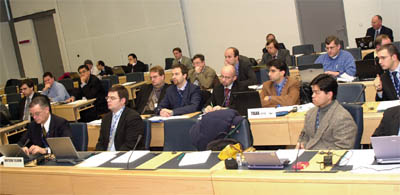IPv6: What future for mobile Internet?*
“IPv6 is here and now. So take the Internet where no other network has gone before,” says Vinton Cerf, Honorary
Chairman of the IPv6 Forum and a leading figure in the Internet.
| * Our cover story is based on the discussions and conclusions of the fourth meeting of the European Commission IPv6 Task Force held at the ITU headquarters at the end of January 2002. The conclusions of the IPv6 Task Force were later presented to the World Telecommunication Development Conference (Istanbul, 18–27 March 2002) under the title: “Internet for Everyone — IPv6 2005 ROADMAP RECOMMENDATIONS”. |
|
|

Photo: Siemens (ITU 020032)
|
The “network of networks”, as the Internet is often referred to, has long been touted to become a network of
everything. Today, some industry experts say that before the world can truly experience next generation communications such as IMT–2000 or third generation (3G) mobile services, it needs to adopt a new protocol known as IPv6 — which stands for Internet protocol version 6. All Internet applications communicate using the Internet protocol (IP). IPv6 is expected to succeed version 4 of the Internet routing protocol (IPv4), which has been in use for over twenty years.
“When the Internet protocol was first conceived, the idea that up to 4 billion Internet hosts would ever be needed to
intercommunicate seemed impossible. However, the success of the Internet, combined with a historically inefficient address allocation system, means that many believe that the Internet is widely perceived to be running out of address
space,” ITU Deputy Secretary-General, Roberto Blois, said in his opening remarks to the fourth meeting of the IPv6 Task Force** held at the ITU headquarters in Geneva in mid-January 2002.>
|
** Exactly two years ago (23–24 March 2000), the European Council at its meeting in Lisbon set the objective for Europe to become the most competitive and dynamic knowledge-based economy by 2010. Providing for an efficient transition to the next generation Internet based on the new Internet Protocol (IPv6) is a crucial factor in this regard. And so the IPv6 Task Force was established with the mandate to examine the current state of the development and deployment of IPv6 and recommend priority actions to be undertaken at European level. |
|
 “When the Internet protocol was first conceived more than twenty years ago, the idea that up to 4 billion Internet hosts would ever be needed to intercommunicate seemed impossible.” “When the Internet protocol was first conceived more than twenty years ago, the idea that up to 4 billion Internet hosts would ever be needed to intercommunicate seemed impossible.”
Roberto Blois
ITU Deputy Secretary-General
Photo: A. de Ferron
(ITU 020034) |

(ITU 020033)
|
|
|
“At the same time, industry initiatives and institutional actions, such as the creation of your Task Force by the European Commission are raising awareness of calls for a rapid evolution towards Internet protocol version 6 (IPv6) to cope with the requirement for a vastly increased IP address space commensurate with the anticipated medium and long-term needs,” Mr Blois also said. He went on to add that by hosting this important meeting, ITU was showing its commitment to keeping its membership informed of the issues related to IPv6 deployment. “We hope thus to be contributing in giving the global reach such an important subject [IPv6] deserves.”
When IPv4 was developed in the 1970s by Internet pioneers such as Vinton Cerf, the vast growth of the Internet was not
foreseen — neither was the conception of the World Wide Web. As a result, and given the limitations of the hardware of the time, the original Internet designers chose to use 32 bits to represent IPv4 addresses. Those 32 bits allow just over 4000 million IPv4 addresses. While the Internet of the late 1970s contained only a handful of hosts, Internet today has reached over 500 million regular users. In comparison, experts say that the major advantage of IPv6 is that it uses 128-bit addresses, enough to offer a globally unique IP address to any device wanting it for the foreseeable future.
|